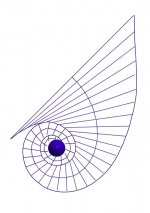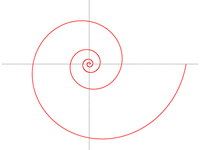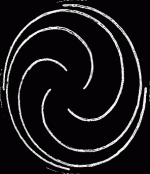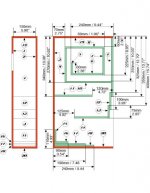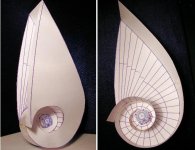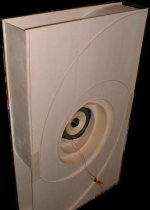Here is a project I'm going to begin. I wanted to try a horn with a "nautilus" shape, but it's like nobody has tried this before (B&W nautilus is based on another concept).
Advantages of this design is that there are no angles, no parrallel surfaces and a very big mouth. Besides it is a "natural" shape.
See the picture attached: it is what I want to build scaled 1:20
This is a stright exponential horn empirically folded as a spiral. The circle at the end of spiral is the driver. The horn is designed to be appended to the wall. Dimensions are quite big: positioned like shown in the picture (mouth line at 45°) it is 250 cm high, 170 cm wide and 60 cm depth (just the first 100 cm from mouth, then goes decreasing to a few cm). A couple of these may fit in a normal free wall 4 m wide.
Having more mathemathical knowledge (that I have not ) would be nice to drow a logarithmic spiral matching the parametters shown below. Somebody maybe can do it?
) would be nice to drow a logarithmic spiral matching the parametters shown below. Somebody maybe can do it?
Parameters:
Flare freq. : 35 hz
Troath area: 70 cm2 (calculated on Fostex FE206E)
reduction ratio: 4 (2 walls)
Horn lenght: 420 cm.
Mouth area : 15039.37 cm2
Mouth section: 60 X 250 cm
Mouth lenght: 250 cm (~ a quarter wave lenght of 35hz)
Although I've already built some enclosures, it's the first thime I do it from scratch. So I wonder how such big things will sound.
Thomas
Advantages of this design is that there are no angles, no parrallel surfaces and a very big mouth. Besides it is a "natural" shape.
See the picture attached: it is what I want to build scaled 1:20
This is a stright exponential horn empirically folded as a spiral. The circle at the end of spiral is the driver. The horn is designed to be appended to the wall. Dimensions are quite big: positioned like shown in the picture (mouth line at 45°) it is 250 cm high, 170 cm wide and 60 cm depth (just the first 100 cm from mouth, then goes decreasing to a few cm). A couple of these may fit in a normal free wall 4 m wide.
Having more mathemathical knowledge (that I have not
 ) would be nice to drow a logarithmic spiral matching the parametters shown below. Somebody maybe can do it?
) would be nice to drow a logarithmic spiral matching the parametters shown below. Somebody maybe can do it?Parameters:
Flare freq. : 35 hz
Troath area: 70 cm2 (calculated on Fostex FE206E)
reduction ratio: 4 (2 walls)
Horn lenght: 420 cm.
Mouth area : 15039.37 cm2
Mouth section: 60 X 250 cm
Mouth lenght: 250 cm (~ a quarter wave lenght of 35hz)
Although I've already built some enclosures, it's the first thime I do it from scratch. So I wonder how such big things will sound.
Thomas
Attachments
Logarithmic spirals:
a spiral is a curve turning around a fixed point growing its distance from that point at each turn.
In a logarithmic spiral this progression is geometrical and is described with a logarithmic formula.
This formula for the curve growth may be the SAME as that commonly used to calculate a normal exponential contour for a straight horn. For my empirical spiral I used an exponential horn formula then turned the contour in a spiral shape with a graphic software.
Should be interesting to have a formula for a spiral horn contour starting from the throath lenght and growing till the mouth lenght at the right distance.
Wife factor:
Yes the horns are big, but they take much less space, in a room, than normal speackers on a stand. The stand must be away from walls then occupies at less one square meter of floor each.
My horns are to be fixed to the wall. Their depth are of 10 to 20 cm from ground to 180 cm. The floor is free. The mouth is against 2 walls, instead of corner: the mouth is bigger, but there is no need to place them away from back wall.
Yes, they occupy the whole wall, but I think they are much cutier, if well finished, then usual big boxes. All the cases, they are for my room (a normal 4x4 m) dedicated to sound listening.
Ciao
Thomas
a spiral is a curve turning around a fixed point growing its distance from that point at each turn.
In a logarithmic spiral this progression is geometrical and is described with a logarithmic formula.
This formula for the curve growth may be the SAME as that commonly used to calculate a normal exponential contour for a straight horn. For my empirical spiral I used an exponential horn formula then turned the contour in a spiral shape with a graphic software.
Should be interesting to have a formula for a spiral horn contour starting from the throath lenght and growing till the mouth lenght at the right distance.
Wife factor:
Yes the horns are big, but they take much less space, in a room, than normal speackers on a stand. The stand must be away from walls then occupies at less one square meter of floor each.
My horns are to be fixed to the wall. Their depth are of 10 to 20 cm from ground to 180 cm. The floor is free. The mouth is against 2 walls, instead of corner: the mouth is bigger, but there is no need to place them away from back wall.
Yes, they occupy the whole wall, but I think they are much cutier, if well finished, then usual big boxes. All the cases, they are for my room (a normal 4x4 m) dedicated to sound listening.
Ciao
Thomas
Attachments
Hi Denis
The coiled exponential horn is what I call "empirical" home made logarithmic spiral. Of course there must be a formula to generate my horn with a logarithmic spiral (but what?), because the growth of both, the straight exponential and spiral, are logarithmic (the last spiral I posted too).
The pure logarithmic spiral shape is a bit different, but, I guess, better, because is the shape used by the nature to fold long things (cyclones, galaxies, spider webs, nutshells..), and is new.
Do you think it will sound? What about the thickness of wood necessary for these big surfaces?
Ciao
Thomas
The coiled exponential horn is what I call "empirical" home made logarithmic spiral. Of course there must be a formula to generate my horn with a logarithmic spiral (but what?), because the growth of both, the straight exponential and spiral, are logarithmic (the last spiral I posted too).
The pure logarithmic spiral shape is a bit different, but, I guess, better, because is the shape used by the nature to fold long things (cyclones, galaxies, spider webs, nutshells..), and is new.
Do you think it will sound? What about the thickness of wood necessary for these big surfaces?
Ciao
Thomas
Hi Dave
From Cornu horns I lent the idea to calculate a straight exponential horn and coil it. But the concept is different: Cornu horn put the driver on the horns mouth, like B&W Nautilus (see picture attached).
My concept is to have an uncompromised stright exponential horn (420 cm long and 1/4 fc wide mouth) without angles. The guess is that coiling the horn in a spiral has same sound than holding it stright.
Ciao
Thomas
From Cornu horns I lent the idea to calculate a straight exponential horn and coil it. But the concept is different: Cornu horn put the driver on the horns mouth, like B&W Nautilus (see picture attached).
My concept is to have an uncompromised stright exponential horn (420 cm long and 1/4 fc wide mouth) without angles. The guess is that coiling the horn in a spiral has same sound than holding it stright.
Ciao
Thomas
Attachments
FE108Sigma spiral
Hi Dave
I've found now the discontinued Fostex FE108Sigma recommended enclosure (see picture attached). Yes, that is the concept. But it is a usual folded horn with square angles that affect sound speed.
Have you other link? Thanks in advance.
Thomas
Hi Dave
I've found now the discontinued Fostex FE108Sigma recommended enclosure (see picture attached). Yes, that is the concept. But it is a usual folded horn with square angles that affect sound speed.
Have you other link? Thanks in advance.
Thomas
Attachments
knorke said:The folding might be good, but I see a problem with the placement of the driver. It's placed in somthing like a tube which will give you nasty resonances and early reflections in the midrange....
I see ...

There would be 2 solutions:
1. The flat side of the horn must be on the front and not on the back (that's done turning on the back the drivers compression chamber)
2. I could add a small midrange horn on the driver, like Oris horns.
What do you think?
thomaseliot said:From Cornu horns I lent the idea to calculate a straight exponential horn and coil it. But the concept is different: Cornu horn put the driver on the horns mouth, like B&W Nautilus (see picture attached).
My concept is to have an uncompromised stright exponential horn (420 cm long and 1/4 fc wide mouth) without angles. The guess is that coiling the horn in a spiral has same sound than holding it stright.
The cornu is an excompromised horn with no angles... the only difference between yours & his is that his horn bifurcates, and then bifurcates again. This keeps the horn side rations closer to a square and allows a very elegant folding into a square.
dave
I see ...
There would be 2 solutions:
1. The flat side of the horn must be on the front and not on the back (that's done turning on the back the drivers compression chamber)
2. I could add a small midrange horn on the driver, like Oris horns.
What do you think? [/B]
1. Then you couldnot place the horn flat on a wall...
2. That would do probably the trick...
One more thing to consider:
horns with smooth folding are said to damp midrange less, so you have a horn with a lot of midrange coming out sideways of the throat.
I would prefer something like the "Little Big Horn" from Carefrae (http://www.carfrae.com ).
They also youse the logarithmic spiral as inspiration.
But it's smaller than your design and needs a subwoofer...
Cornu horn
Hi Dave, Variac,
very pleased you are here, maybe you have some wise hints for me. Yes I was wrong, I found the right picture (attached).
Nonetheless Cornu horn has (relatively) small mouths and is rated (Großes Spiralhorn 2nd) at 70Hz Low Fc.
What I want to build is a very big mouth: 250 cm, that is about 1/4 of the lenght of the 35hz wave. Have you another project with so a big mouth to hint to me?
I've just taken from Cornu the idea of coiling a horn in a spiral schape and attach it to the wall, to fit a big horn in a normal room. A "normal" boxed horn would be too big with such a mouth (even placed in a corner). For the rest, Cornu horn is just another project.
My problem is the behaviour of the big mouth, for istance the problem raised by Knorke, about the amount of midranges coming out from the rear of the driver.
Just now i'm trying to decide the dimensions of the rear driver chamber. What's your opinion?
Ciao
Thomas
Hi Dave, Variac,
very pleased you are here, maybe you have some wise hints for me. Yes I was wrong, I found the right picture (attached).
Nonetheless Cornu horn has (relatively) small mouths and is rated (Großes Spiralhorn 2nd) at 70Hz Low Fc.
What I want to build is a very big mouth: 250 cm, that is about 1/4 of the lenght of the 35hz wave. Have you another project with so a big mouth to hint to me?
I've just taken from Cornu the idea of coiling a horn in a spiral schape and attach it to the wall, to fit a big horn in a normal room. A "normal" boxed horn would be too big with such a mouth (even placed in a corner). For the rest, Cornu horn is just another project.
My problem is the behaviour of the big mouth, for istance the problem raised by Knorke, about the amount of midranges coming out from the rear of the driver.
Just now i'm trying to decide the dimensions of the rear driver chamber. What's your opinion?
Ciao
Thomas
Attachments
knorke said:
1. Then you couldnot place the horn flat on a wall...
2. That would do probably the trick...
One more thing to consider:
horns with smooth folding are said to damp midrange less, so you have a horn with a lot of midrange coming out sideways of the throat.
I would prefer something like the "Little Big Horn" from Carefrae (http://www.carfrae.com ).
They also youse the logarithmic spiral as inspiration.
But it's smaller than your design and needs a subwoofer...
Hi
thank for the reply.
The horn can pe appended the same, because the mouth surfaces are parallel (i will show a modified model)
Can you tell me more about the midrange coming from rear or a link where to learn more?
Ciao
Thomas
P.S.
I've seen the the Carfrae "Big horn" without subwoofer. This big thing is 180 cm tall, goes to a room corner taking lot of space, and has not so a big mouth.
Externally it looks a little like the one in my avatar, however, mine is really similar to a horn loaded base reflex instead of a true horn, and it's really a small speaker (43cmW, 30cmH, 11cmD). The reason why I went with this kind of design was the size was limited, and cone drivers need enough back volume to have an open sound. If the back volume is too small, then the music will sound dead because the back air is damping the cone too much as the lower frequencies move the cone in and out.
I think there are two programs you can use to simulate this: AJHorn and the Mathcad Worksheets developed by Martin. I think AJHorn is free, but you cannot save or read data. Martins worksheets are good, and it's a good value for DIY.
Let's try to figure out what the simulation works first, and take it from there, and hope others with more horn experience to pop in.
A large horn like that needs lots of room after the mouth, otherwise waves will reflect back into the horn and effect its performance. I have not made a large horn like that myself, so it's only possible to make an estimate based on understanding of how waves propegate.
I think there are two programs you can use to simulate this: AJHorn and the Mathcad Worksheets developed by Martin. I think AJHorn is free, but you cannot save or read data. Martins worksheets are good, and it's a good value for DIY.
Let's try to figure out what the simulation works first, and take it from there, and hope others with more horn experience to pop in.
A large horn like that needs lots of room after the mouth, otherwise waves will reflect back into the horn and effect its performance. I have not made a large horn like that myself, so it's only possible to make an estimate based on understanding of how waves propegate.
One more thing to mention is that horns have harmonics of their own. You may or may not like those harmonics. From a HiFi point of view is to try and minimize those harmonics and enhance the low frequency only. In order to do that, we also tried to make the thoat thin and wide for a given through area to minimize the chances of high frequencies going though while also doing the best to absorb the high frequencies in the chamber.
This paint previously recommended by another member seems interesting for horn interior.
http://www.hytechsales.com/prod150.html
Here are a few ways to draw a nautilus shape.
http://jwilson.coe.uga.edu/emt669/Student.Folders/Frietag.Mark/Homepage/Goldenratio/goldenratio.html
and some more information
http://www2.mat.dtu.dk/people/V.L.Hansen/nautilus/naustory.html
I think if you use the nautilus shape, the mouth will become very large in a shorter distance.
This paint previously recommended by another member seems interesting for horn interior.
http://www.hytechsales.com/prod150.html
Here are a few ways to draw a nautilus shape.
http://jwilson.coe.uga.edu/emt669/Student.Folders/Frietag.Mark/Homepage/Goldenratio/goldenratio.html
and some more information
http://www2.mat.dtu.dk/people/V.L.Hansen/nautilus/naustory.html
I think if you use the nautilus shape, the mouth will become very large in a shorter distance.
- Status
- This old topic is closed. If you want to reopen this topic, contact a moderator using the "Report Post" button.
- Home
- Loudspeakers
- Full Range
- Back loaded big spiral horn with Fostex FE206E
